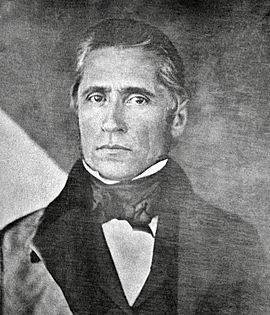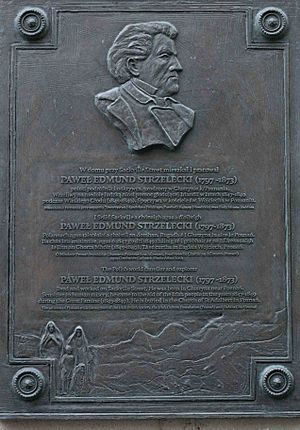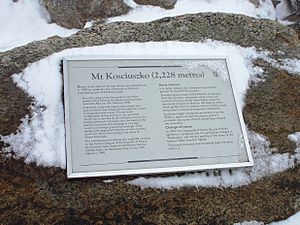Paweł Strzelecki facts for kids
Quick facts for kids
Sir Paweł Edmund Strzelecki
|
|
|---|---|

Photograph taken about 1845
|
|
| Born | July 20, 1797 |
| Died | October 6, 1873 (aged 76) |
| Resting place | Church of St. Adalbert, Poznań, Poland |
| Nationality | Polish, British Citizen from 1845 |
| Alma mater | University of Heidelberg |
| Occupation | Geographer, geologist, explorer |
| Known for | Exploration of Australia, work for the Great Famine (Ireland) |
| Awards | Founder's Medal (1846) Companion, Order of the Bath (1849) Knight Grand Cross, Order of St Michael and St George (1869), Fellow of the Royal Society, Fellow of the Royal Geographical Society, Honorary Doctorate of Civil Law (Oxon.) |
Sir Paweł Edmund Strzelecki (born July 20, 1797 – died October 6, 1873) was a Polish explorer, geologist, and humanitarian. He became a British citizen in 1845. He is famous for exploring Australia, especially the Snowy Mountains and Tasmania. He also climbed and named Australia's highest mountain, Mount Kosciuszko.
Contents
Early Life and Travels
Strzelecki was born in 1797 in Głuszyna, near Poznań, which was then part of Prussia. His family was Polish nobility. He left school early and served briefly in the Prussian Army. He resigned because he didn't like the strict rules.
Later, he worked as a tutor. He fell in love with a young student, Adyna Turno, but her father did not approve. Even though they never married, they wrote letters to each other for over 40 years.
With money from his family, Strzelecki traveled in Austria and Italy. He then managed a large estate in Poland for Prince Franciszek Sapieha. After the prince died, Strzelecki left Poland around 1829 and traveled to France and Africa.
He didn't have formal training in geology, which was a new science then. He likely learned about it on his own.
In 1834, he sailed to New York. He traveled widely in North America, studying soil and minerals. He also visited farms to learn about keeping soil healthy. In South America, he explored important mineral areas. During this time, he strongly opposed the slave trade. He continued his travels to Cuba, Tahiti, and New Zealand before arriving in Australia.
Exploring Australia

Strzelecki arrived in Sydney, Australia, on April 25, 1839. He visited his friend James Macarthur's estate. He was very interested in Australia's minerals.
In September 1839, he found gold and silver near Wellington, New South Wales. He sent samples to geologists in London and Berlin. However, the Governor of New South Wales, Sir George Gipps, kept the discovery a secret. He was worried that 45,000 convicts might cause trouble if they heard about the gold.
Later in 1839, Strzelecki began an expedition into the Australian Alps. He explored the Snowy Mountains with James Macarthur, James Riley, and two Aboriginal guides, Charlie Tarra and Jackey. In 1840, he climbed the highest peak in mainland Australia. He named it Mount Kosciuszko to honor Tadeusz Kościuszko, a Polish national hero.
From there, Strzelecki explored a region he named Gippsland, after the governor. The journey was very difficult. They had to leave their horses and collected samples behind. For 22 days, they faced starvation. Their guide, Charlie, saved them by hunting native animals for food. The group finally reached Western Port on May 12, 1840, and Melbourne on May 28. The Strzelecki Ranges in Victoria are named after him.
From 1840 to 1842, Strzelecki explored nearly all of Tasmania (then called Van Diemen's Land). He often traveled on foot with three men and two pack horses. The Lieutenant-Governor, Sir John Franklin, and his wife, Lady Jane, helped him with his scientific work.
Strzelecki left Tasmania in September 1842 and returned to Sydney. He continued collecting samples in northern New South Wales. On April 22, 1843, he left Sydney after traveling about 11,000 kilometers (6,800 miles) through New South Wales, Victoria, and Tasmania. He studied the geology along the way. He then traveled to China, the East Indies, and Egypt before going to England.
In 1845, he published his book, Physical Description of New South Wales and Van Diemen's Land. The book was praised by scientists like Charles Darwin. It was a key source of information about Australia for many years. In his book, he wrote that Aboriginal Australians were strongly connected to their land, just like Europeans. He also created the first map of Gippsland and a large geological map of Eastern Australia and Tasmania.
In 1845, he became a British citizen.
Helping Others

During the terrible Irish Potato Famine in 1846–47, many people in Ireland were starving. In January 1847, a group called the British Relief Association raised money to help. They asked Strzelecki to manage the distribution of aid, which was a huge amount of money.
Strzelecki was in charge of giving out supplies in three counties: Sligo, Mayo, and Donegal. To help starving families, especially children, he came up with a brilliant idea: feeding children directly through schools. He gave daily food to schoolchildren in the worst-hit areas. He also gave out clothes and taught about basic hygiene. At its peak in 1848, about 200,000 children were fed through these efforts. Many of them would have died without his help.
Even though he got sick with typhoid fever in Ireland, Strzelecki worked tirelessly to help. People at the time greatly admired his dedication. For his services, he received an award called Companion of the Order of the Bath in 1848.
Strzelecki also helped poor Irish families move to Australia for a new life. For many years, he was an active member of the Family Colonisation Loan Society, which helped people move. In 1854, he became its chairman.
He was also part of several committees that helped people move to new places. He helped Florence Nightingale publish some of her writings.
Strzelecki died in London in 1873 from liver cancer. In 1997, his remains were moved to the Church of St. Adalbert in his hometown of Poznań, Poland.
Awards and Honours
Strzelecki became a fellow of the Royal Geographical Society. He received its Founder's Medal for his explorations in Australia. The Society still displays his large geological map of New South Wales and Tasmania.
He was also made a Fellow of the Royal Society, recognized for his work as an explorer and humanitarian.
He received an honorary degree from the University of Oxford. He was also awarded Companion of the Order of the Bath (CB) in 1849 and Knight Commander of the Order of St Michael and St George (KCMG) in 1869.
In 1983, Australia Post honored him with a postage stamp featuring his portrait.
Places Named After Him

In Australia
- Strzelecki Ranges, Victoria, which includes the town of Strzelecki.
- Mount Strzelecki, Northern Territory
- Strzelecki Peak, Flinders Island
- Strzelecki Creek, South Australia
- Strzelecki Highway, Victoria
- Strzelecki Track, South Australia
- Strzelecki Desert, east of Lake Eyre in South Australia
- Strzelecki Scenic Lookout, Newcastle, New South Wales
In Canada
- Strzelecki Harbour
Writings
- Physical Description of New South Wales. Accompanied by a Geological Map, Sections and Diagrams, and Figures of the Organic Remains (London, 1845).
See also
- Poles in the United Kingdom

